Sea Slugs Scrub Seagrass by the Seashore
“They’re so majestic,” ecologist Brent Hughes says as he looks out across Elkhorn Slough, a large winding estuary off the Monterey Bay coastline. He’s not talking about whales or pelicans. He’s talking about a tiny, slimy, aquatic slug — the eelgrass sea hare. Donning his wetsuit, Hughes hops into his kayak and paddles off toward a section of water where the sea hares live, in an underwater meadow of seagrass.
Also known as the Taylor’s sea hare, these humble, zebra-striped slices of green jello are actually crucial to the health of their eelgrass meadow ecosystem.
Eelgrass sea hares — named for the bunny-like tentacles on top of their heads — can be found munching on the microscopic algae that grow on the surface of eelgrass, a type of marine seagrass. They don’t eat the grass itself; instead they help the meadows grow by clearing the way for sunlight to reach the plants, scraping the blades of grass clean with their rows of tiny teeth. The seagrass, in turn, serves as a safe haven to lay their eggs, and protection from predators like crabs and fish.
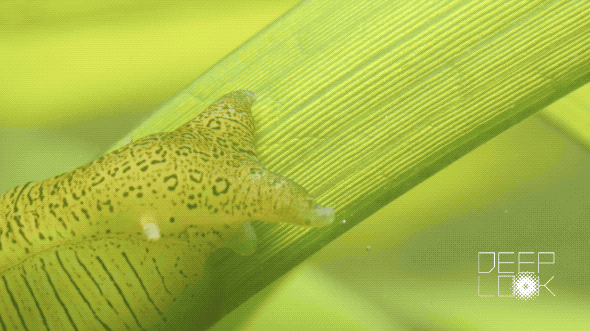
The blades of grass also protect more than just these voracious little cleaners. At Elkhorn Slough off of the Monterey Bay, the eelgrass beds form a habitat for a diverse community of animals and plant life, which includes sea otters, Dungeness crabs, clams, skeleton shrimp and various fish.
“Eelgrass is like the ugly duckling of the charismatic habitat world,” says biologist Grace Ha of UC Davis, who studied the camouflage of the Taylor’s sea hare. “Seagrasses are among the most productive habitats in the world, if you compare them to rainforest or coral reefs, but most people don’t even know what eelgrass is.”
Eelgrass forms submarine meadows in shallow seawater, estuaries and salt marshes across the Northern Hemisphere. Seagrasses absorb carbon from the atmosphere and prevent coastal erosion, but climate change, and human activities like large-scale agriculture threaten their existence worldwide. Biologists compare the steady decline of seagrass beds to the global crises of disappearing rainforests and coral reefs.
For decades, the eelgrass meadows of Elkhorn Slough were also disappearing. Since the 1950s nitrogen-based fertilizers from farms in the Salinas Valley have drained into the estuary, overloading the water with nutrients, causing massive algae blooms. Too much algae living on the surface of the water blocks the sunlight necessary for eelgrass meadows to grow, and the grasses begin to die out.
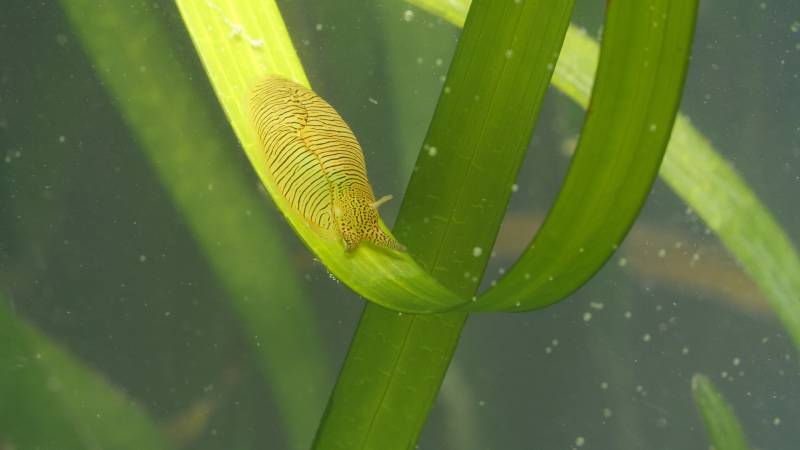
In 2013, Hughes, now at Sonoma State University, published the results of a surprising discovery. He noticed that the eelgrass in Elkhorn Slough was actually rebounding, despite the extreme algal blooms. Strangely, his data showed, this was happening right around the time sea otters were reintroduced to the area.
Sea otters had been totally missing from the estuary ecosystem since the early 20th century. By that time, fur traders had hunted otters almost to extinction along the California coast. But in the late 1980s, the Monterey Bay Aquarium rereleased a small population of sea otters back into the slough, and their numbers have steadily increased.
Hughes’ research established that the hungry otters were eating copious amounts of local crabs, a natural predator of Taylor’s sea hares. “The otters recovering allowed for an explosion of sea hares that really kind of facilitated the resilience of that seagrass.”
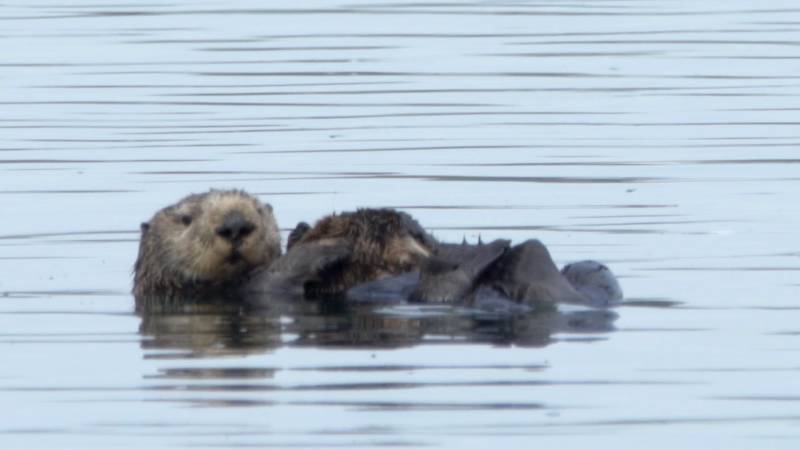
Hughes and his colleagues had uncovered a trophic cascade in which the reintroduction of a top predator (in this case the sea otter) results in a balancing effect on the food web.
In an eelgrass ecosystem like Elkhorn Slough, where nutrient-polluted waters cause regular extreme algal blooms, the “grazers just become really, really important for controlling that algal overgrowth.” When otters were missing and not eating crabs, the crab population grew and ate too many sea hares, so the eelgrass had less help dealing with the suffocating algae growth.
“The remarkable thing is that the nutrients are still climbing,” Hughes said. “It’s insane how high the nutrients are in that system.” Despite this continued stress on the ecosystem, the eelgrass meadows in Elkhorn Slough have in fact steadily expanded over the past three decades. Hughes credits the otters and their trophic cascade relationship with the sea hares.
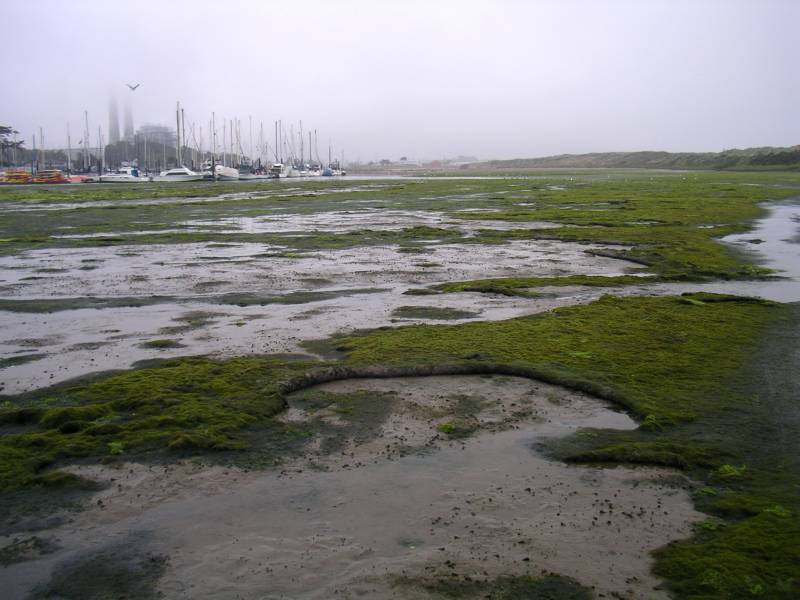
“These grazers are so abundant in Elkhorn Slough, you just have to reach over and grab some seagrass and you’ll end up grabbing a few sea hares too.”
Further north, in the San Francisco Bay, Kathy Boyer has been working for years to restore native eelgrass ecosystems. Eelgrass sea hares had also been easy to find in the meadows she was restoring, until recently.
2017 was an extremely wet winter and spring for the San Francisco Bay Area. Storm after storm brought so much fresh water to the bay that salinity dropped well below the usual level (below ten parts per thousand). Very soon after this dramatic drop in salinity, Boyer and her colleagues noticed that the Taylor’s sea hare (and another symbiotic grazer called the eelgrass isopod) had disappeared from the meadows in the bay. The sea hares had simply vanished from the eight eelgrass restoration sites she and her team had been monitoring.
“It was shocking,” she says. “We’ve definitely seen fluctuations in invertebrate populations, but we’ve never seen the complete loss of species.”
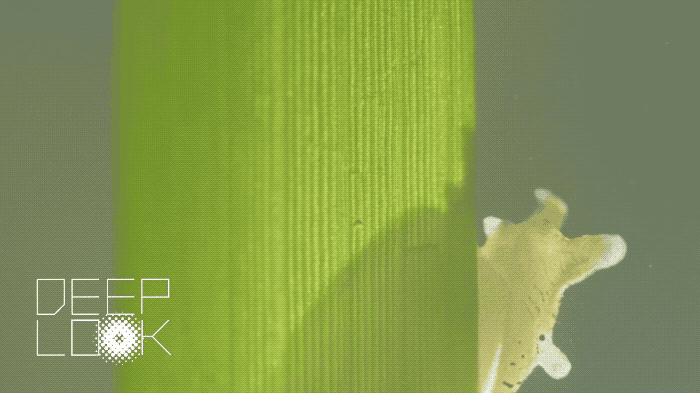
Boyer and her team realized at that moment that the only places in the San Francisco Bay with living Taylor’s sea hares were the experimental holding tanks where she does most of her eelgrass restoration studies, at San Francisco State University’s Estuary and Ocean Science Center in Tiburon.
Boyer immediately recognized the importance of the animals in her tanks. “We’ve got to try to keep these guys alive, because it’s all that’s left of this population.”
She hopes to grow the population, and eventually reestablish them throughout eelgrass meadows in the bay. The good news is “they’re reproducing like crazy, they’re really happy in the tanks. They’ve got no predators, so they’re just doing their thing.”
Having worked in ecosystem restoration for years, Boyer intimately understands the complexities inherent to the work.
“There’s lots of interest in just going out and restoring a bunch of eelgrass, but the grass doesn’t live in a vacuum out there in the bay. It interacts with all these other species. It brings up lots of questions about ‘What are restoration best practices?’”
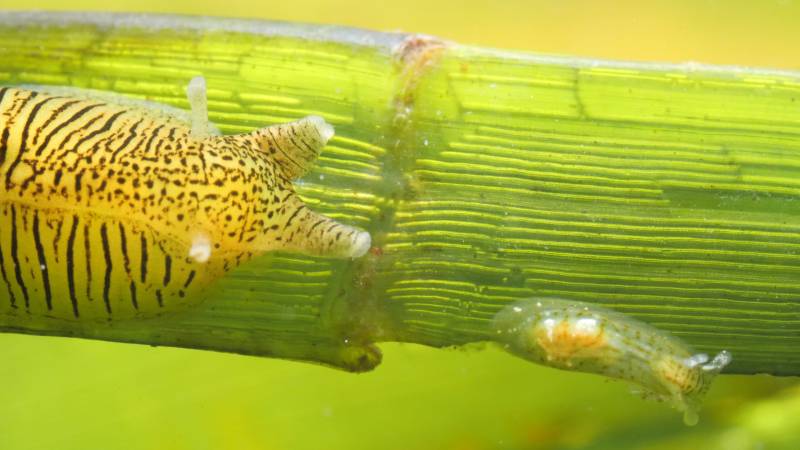
The disappearance of the sea hares offers a rare opportunity to observe what happens when a species suddenly vanishes from an ecosystem. “Sometimes you don’t know what you have until you lose a bit of it,” Boyer said.
Also, Elkhorn Slough has sea otters, but the San Francisco Bay does not, which translates to a big difference in how the food webs function in each location.
“Whether the trophic cascade will have the same levels, and effect, as Brent is seeing down in Elkhorn, we really have no idea,” says Boyer.
There are different sets of animals in the food web in the San Francisco Bay, but it seems that reintroducing otters is a real possibility. Because their populations have been so scarce over the past century, scientists had assumed sea otters lived primarily in ocean waters.
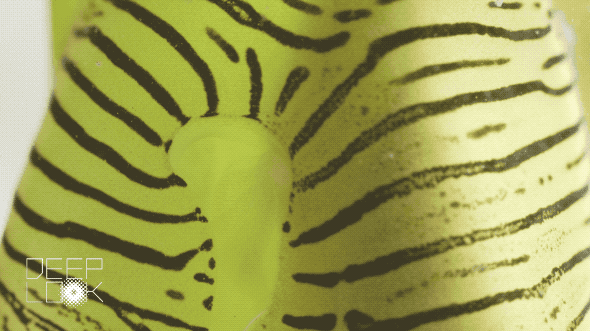
“The amazing thing with the otters is that as they’re recovering, they’re revealing their true range of habitats that they can use right now,” Hughes says, citing the recent success of the Elkhorn Slough otter population.
“Now researchers are focusing on these estuaries as areas for sea otter recovery, in areas away from predators, away from big waves that you might experience in a kelp forest, somewhat removed from human influence”
Both Boyer and Hughes are co-authors of a research paper suggesting that if properly reintroduced, the San Francisco Bay could be home to as many as 6,000 sea otters, effectively tripling the current population of sea otters in California.
Whether or not sea otters should be a part of the Taylor’s sea hare reintroduction plan in the San Francisco Bay is still an open question, but it is definitely on Boyer’s mind as she wrestles with the complex decisions of when and how to bring the sea hares back to the bay’s meadows.
Despite the challenges of eelgrass ecosystem restoration, Hughes remains inspired by the example of the Taylor’s sea hares. He says Elkhorn Slough is “a gold mine in terms of scientific discoveries. It’s a story of recovery, of conservation, and it involves not only the imperiled species, the sea otter, but these imperiled habitats that they’re returning to, such as seagrasses and salt marshes.”
It’s also a story of how even a little green slug can be so much more important than its modest appearance might, at first, suggest.